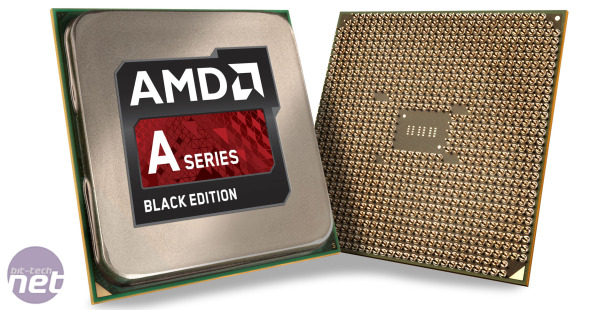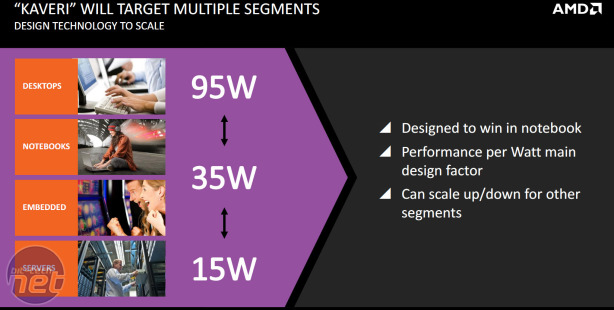
AMD A8-7600 (Kaveri) Review
Manufacturer: AMDUK price (as reviewed): approx. £90-95 (inc VAT)
US price (as reviewed): $119 (ex Tax)
Today marks the launch of AMD's Kaveri range, the latest generation of its Fusion APUs and the upgrade to last year's Richland. Launching first will be the two top-end parts, characterised as such by their A10 prefix, with the lowlier parts to follow in the coming months.
The first set of APUs, codenamed Llano and launching in 2011, were mainly about combining the CPU and GPU onto the same silicon. Then came Trinity, swiftly followed by turbo-charged Trinity (Richland), which updated the architecture with better compute functionality and power management. Kaveri, however, is all about uniting the two processors in ways that extend beyond just having them together on a die, something that is achieved using what AMD calls Heterogeneous System Architecture (HSA). Therefore, along with updates to both the CPU and GPU architectures, there are changes to the ways that they're able to interact with one another, and we'll be covering each of these facets separately over the coming pages.
Kaveri is also the first AMD processor to be exclusive to the new FM2+ platform, which brings with it two new chipsets (A88X and A78). It will also be used within the existing A55 chipset at the lower end. Each of these chipsets support AMD's new configurable TDP feature as well as DotHill RAID.
While owners of older FM2 motherboards won't be able to upgrade to Kaveri, thanks to its two extra pins, FM2+ board owners can at least use old Richland and Trinity APUs, making for at least one avenue to staggered upgrading.
The Kaveri chip has a 245mm2 die area and consists of 2.41 billion transistors. It's built on a new 28nm process (until now the APUs have been 32nm) from Global Foundries. AMD has shared the details of three chips, with the less powerful variants still to come.
| APU Model | A10-7850K | A10-7700K | A8-7600 |
| Compute Cores | 12 (4 CPU / 8 GPU) | 10 (4 CPU / 6GPU) | 10 (4 CPU / 6GPU) |
| TDP | 95W | 95W | 65W / 45W |
| CPU Base Clock | 3.7GHz | 3.4GHz | 3.3GHz / 3.1GHz |
| CPU Turbo Clock | 4.0Ghz | 3.8GHz | 3.8GHz / 3.3GHz |
| Total L2 Cache | 4MB | 4MB | 4MB |
| GPU Clock | 720MHz | 720MHz | 720MHz |
| Max DDR3 Speed | 2,133MHz | 2,133MHz | 2,133MHz (?) |
| Unlocked Multiplier | Yes | Yes | No |
| RRP | £128 | £113 | $119 (£90~£95?) |
According to AMD, performance per watt was Kaveri's main design parameter. As with previous APUs, this ties in with an increased focus on portable devices, where battery life is key. AMD admits that performance improvements in this regard will be more apparent at lower TDPs, but increased efficiency is still good to see in the desktop space as well.
Socketed desktop Kaveri parts fall into the 45W-95W range, although it will go as low as 15W in embedded and portable versions. The A10-7850K takes the places of the A10-6800K as the flagship APU, and both it and the other A10 chip are rated for 95W and fully unlocked. Interestingly, these two chips have lower TDPs and clock speeds than those which they replace, which is partly a result of the move to 28nmand partly through other power-saving measures. These two top end chips will also ship with a free copy of Battlefield 4.
The A8-7600 is a 65W chip, but it has also been optimised to run at 45W should a user wish. The configurable TDP feature (toggled in the BIOS), may work with other APUs too, but only for this one has it been optimised (so far). This is potentially good news for those interested in small form factors, where reducing heat and noise is even more critical.
The approach AMD has taken to Kaveri's launch is odd, to say the least. You may have noticed that the title of this review refers to the A8-7600, despite its availability only being earmarked as Q1 2014 while the A10 parts can be bought now. This isn't a typo – for one reason or another, the A8-7600 is the only chip we've received for review. As such, we'll be discussing architectural changes now (since these apply to the whole range), but the flagship review will have to wait until we can source a sample.

MSI MPG Velox 100R Chassis Review
October 14 2021 | 15:04










Want to comment? Please log in.